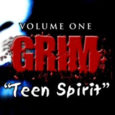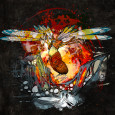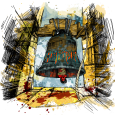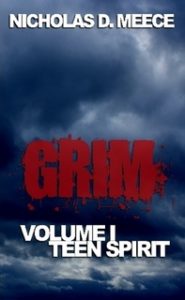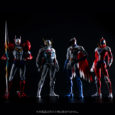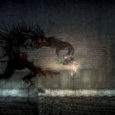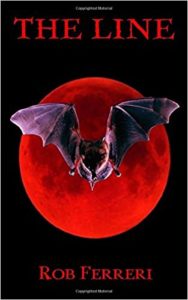 Vampires are a staple of Halloween and one of the most famous horror icons around. So I figured reading a vampire tale for Hallow-Reads was as good an idea as any. That’s when I was presented with The Line by Rob Ferreri, a self-published novel about a team of vampire hunters.
Vampires are a staple of Halloween and one of the most famous horror icons around. So I figured reading a vampire tale for Hallow-Reads was as good an idea as any. That’s when I was presented with The Line by Rob Ferreri, a self-published novel about a team of vampire hunters.
The Line tells the story of Alexander, an immortal ex-vampire and his mission to hide an ancient amulet from Dorian, his ex-master. When the amulet is discovered in present day New York, Alexander assembles a team to help him combat the vampire threat and protect the amulet. The team, which he dubs “the Line” are chosen ones, people who come from a long line of vampire slayers. The plot boils down to Buffy the Vampire Slayer meets The Avengers and works in many ways. However, there are quite a few ways that it just falls flat.
The book opens with a scene of our Alexander being healed of his vampirism and turning against his former brethren. It’s an interesting concept, one that doesn’t get explored often in pop culture, but it also doesn’t get explored much here, either. We know Alexander had a history as a vampire and worked with Dorian, but Ferreri never delves into that. There’s no back story showing us how Alexander became a vampire or what regrets he may have. We’re only told he was a vampire, isn’t any more, and now wants to rid the world of vampires.
The dialogue tags were the most tedious part of the book. Dialogue tags should be straightforward as the most effective ones are a simple “she said” or “he asked.” Sure, it’s great to mix them up a bit for some exclaiming, questioning, or accusing. But The Line makes them all as homogenous as possible. Every dialogue tag follows all of the dialogue. Every time. Now, this isn’t how most authors handle it; in scenes with two characters, for example, it’s generally easy to follow the flow of the dialogue, making the need for a tag each time unnecessary. But Ferreri uses them for every line and it gets very distracting.
From my understanding, The Line was originally written as a screenplay, and after reading it, that’s fairly obvious. The dialogue tags, for example, reminded me of slugs, the character name that precedes each line of dialogue, making it easy for the actor to know which lines are theirs and which belong to their costars. Sure, Ferreri punches up his dialogue with adverbs, but these are little more than parentheticals, the stage direction used to indicate how the actor should deliver the line.
This isn’t the only similarity The Line as a novel has to a screenplay. The book focuses a lot on the action; every few pages, a new action scene occurs. Whether it’s a showdown between the protagonists and the bad guys or some sort of training exercise, action scenes take precedence. Which makes sense considering The Line is a vampire based action adventure more than anything else. However, this focus detracts from any sort of character development, of which there is very little.
The Line is straight forward, to the point, and exactly what one could expect from a ninety minute action flick.
Does a novel need chapters of deep backstory to be enjoyable? No, not at all, but unlike movies, novels aren’t constrained by a certain length. There’s no hard and fast rule that a novel should be a set number of pages. In that sense, novels have an advantage over films when it comes to character development.
The Line implements a sort of ticking clock, yet another action movie trope. Alexander and Co must stop Dorian from getting the other half of the artifact before the next lunar eclipse or the world will suffer. Because of this, the plot moves at hyperspeed. Characters are introduced, destinies explained, trainings held, and lots of fight. There’s no time to get to know the cast. We see them put through the wringers of training a total of one time before they accept their fate. They trust each other implicitly after knowing each other for at most a couple of days. There’s very little internal conflict and it gets resolved in a page or two, which diminishes the stakes.
The parallel between The Line as a novel versus a screenplay makes sense when you look at author Rob Ferreri’s history. He’s worked on a few full-length feature films, most of which were made prior to the publication of The Line. He clearly has a strong grasp of writing, but it seems that scripting is a difficult habit to shake. Novels and screenplays are two different creatures and what works in one doesn’t necessarily work in the other. I don’t feel that his writing style is bad; just that it’s not the ideal approach for a novel.
Don’t get me wrong; there are quite a few good parts about The Line, most notably the character introductions. When we meet each of the characters, they get the spotlight in their own little vignette of a story. Detective Jay Hong is ambushed during one of the biggest cases of his career. The Blades brothers, Diego and Julian, are career criminals and we first see them during a high-octane car theft and eventual chase. Lena Somnianti is a sophisticated artist and fencer, a well-travelled and intelligent woman. They all make grand entrances, yet don’t really live up to their promise. Sure, they’re competent enough in their own right but none of them ever feel fleshed out besides what we learn at the outset.
This is really the fatal flaw of The Line. It never really lives up to its own story. It’s complete, has a plot and a diverse cast, but that’s the bare minimum when dealing with a novel. As a film, The Line would have been magnificent fun. More Underworld than Anne Rice, it didn’t quite fit into my idea of “horror” so it probably wasn’t the best entry for Hallow-Reads, but I still found myself engrossed in the tale as it unfolded.
The Line is available on Amazon. You can also see more of Ferreri’s work by visiting his comic publisher, Evil Kat Comix.
Grade: C
Don’t forget to try our Ten Family Friendly Halloween Movies to help lull the kiddos into a candy coma! Afterward, you can set the mood with Five Albums to Flesh Out Your Halloween Playlist and huddle under the covers with Netflix and Chilling – Halloween Movie Edition. Any other off-beat Halloween suggestions to throw our way? You can let us know on Twitter @SubCultured or come party like its 1599 in our Discord server!
Halloween is one of my favorite holidays. Besides all of the cute decorations, cooler weather and delicious special edition food and candy, it’s also the time to plant oneself in front of the television and binge watch scary movies. But what does one do when movies get boring? Turning to books is usually a good idea. Thankfully there’s a subset of writers who focus on telling spooky, scary, or downright grisly tales that are best enjoyed during Halloween. I had the chance to check out one of these tales, Grim, Volume I: Teen Spirit, by Nicholas Meece.
Teen Spirit starts with a grisly murder outside of a nightclub in a small town before transitioning to the story of Steve, a teenager and budding writer, and his best friend, Jen. They share a passion for filmmaking and horror movies, so when Steve tells Jen about the murder and convinces her to investigate it with him, she’s all in. The murders don’t stop there, though, as the Reaper, as he’s known, tears through the town, killing people very close to Steve’s and Jen’s houses.
While I enjoyed Teen Spirit, I do have to say it’s full of missed potential. There are a lot of great moments in it, such as the opening prologue with the murder, which sets the tone for the horror-themed story. However, once our main characters are introduced, a lot just seems to get lost along the way. We meet Steve and find his passion for writing leads him to lock himself in his bedroom for hours on end to finish a work in progress. He’s secretive about his hobby, not allowing anyone to read his stories until he feels they are perfect. He’s in love with his best friend Jen and wants their relationship to blossom into more than just friendship, but they also plan on moving to California and living together, which is slightly weird but at least makes some sort of sense.
Steve gets the most depth while, unfortunately, Jen is more of a one-note character. We know she’s interested in filmmaking and wants to move to California. She likes Steve’s company but doesn’t see him romantically like he sees her. That is, until she’s told that she does see him romantically by a mutual friend. It’s an odd exchange and one that doesn’t really feel natural. In fact, most of the women in the book come off as caricatures, more like plot devices than real women. The exchanges between Jen and her friend Angela feel forced and stilted. There are so few of them that they’re easy to overlook, but the book is so short that these exchanges are huge chunks of the word count.
I thought the story started to pick up around the time Steve convinces Jen to investigate the murder with him. This could have made for an interesting tale and was the thread that I was most looking forward to; two teenagers struggling to use second hand knowledge of police procedurals and figure out who committed a grisly murder would have made for an intriguing tale. Couple that with the twist ending and Steve’s true agenda could have made it even more engaging. It soon becomes apparent, though, that their sleuthing isn’t the purpose of the tale. Meece is taking his love for horror movies and creating a slasher story. However, with a little fleshing out, he could have blended the two genres and created something with a little more meat on the bone.
That’s not to say Teen Spirit isn’t entertaining. It’s just heavily bogged down in horror movie tropes. A couple of fresh out of school kids in their sexual prime. An alcohol-fueled house party that swells out of control. The caring, housewife who’s concerned for the wellbeing of her taciturn son. The inclusion of all of these seem intentional based on Meece’s love of horror. After reading through Teen Spirit, I didn’t quite make this connection and the tropes bothered me. However, I dwelled on the story for a few days before starting writing this and I developed a deeper appreciation for it.
It’s hard for me to go into depth for a review of Teen Spirit only because of how short the story is. I read it entirely in a single train ride of only about an hour, which isn’t a lot of time for a “book.” That’s why my biggest disappointment with Teen Spirit is its length. As I mentioned earlier, there were plenty of areas that Meece could have elaborated on the story, delving deeper into character histories and motivations and actually following through with Steve and Jen’s intentions of tracking the killer. I assume he didn’t do this because he intended to write a short and sweet slasher tale which, if that is the case, he at least succeeded in doing. One benefit Teen Spirit does have is its cliffhanger ending, hinting at a much larger story looming in the distance. As of the time I’m writing this, there has not been a release of Grim, Volume 2, which is slightly disappointing. Hopefully, that’s still on Meece’s “To Do” list and hasn’t been abandoned completely.
All in all, I would recommend Grim, Volume I: Teen Spirit if you’re bored with horror movies on Netflix and are just looking for a change of pace. While it’s not as deep as a Stephen King novel, it provides a quick dose of horror-fueled entertainment. Not too long to get boring, but just long enough to create a creepy, slasher atmosphere. And if you crave more, you can always check out Meece’s non-fiction and movie reviews over at www.morbidmuch.com. He’s definitely a proponent of horror and a voice that adds to the genre.
Grade: B-
Don’t forget to try our Ten Family Friendly Halloween Movies to help lull the kiddos into a candy coma! Afterward, you can set the mood with Five Albums to Flesh Out Your Halloween Playlist and huddle under the covers with Netflix and Chilling – Halloween Movie Edition. Any other off-beat Halloween suggestions to throw our way? You can let us know on Twitter @SubCultured or come party like its 1599 in our Discord server!
Recently, I was asked to write an advance review for a forthcoming science fiction novel from a small press. I jumped at the opportunity to read the book before fully contemplating if it would be worth the time. Smaller presses are always a gamble in terms of quality, both with the writing and the printing, so for all I knew I was in for a terrible reading experience. I decided to plow through with the review anyway and soon found Leech Girl Lives by Rick Claypool and Spaceboy Books in my inbox. So, were my fears justified or was Leech Girl Lives worth the effort of a read through?
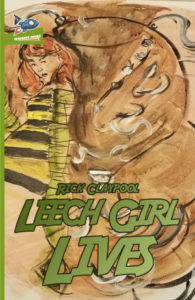 Leech Girl Lives takes place in a dystopian future where the majority of humanity has died out and what’s left live in a domed city called the Bublinaplex. While the Bublinaplex is surrounded by a “Fungus Wasteland” filled with large, horrendous and terrifying creatures, the people have managed to build a pretty stable world which is overly concerned with safety. This is where our protagonist comes in.
Leech Girl Lives takes place in a dystopian future where the majority of humanity has died out and what’s left live in a domed city called the Bublinaplex. While the Bublinaplex is surrounded by a “Fungus Wasteland” filled with large, horrendous and terrifying creatures, the people have managed to build a pretty stable world which is overly concerned with safety. This is where our protagonist comes in.
Margo Chicago is an Art Safety Inspector who investigates all works of art put on display to ensure that the artwork doesn’t hurt anyone. She has a fairly important job because the denizens of the Bublinaplex are all encouraged to work on some sort of “creative pursuit.” Some of these are worthwhile, like painting and singing while others, like Margo’s desire to crochet cats, are a little offbeat. Others still are just asinine, like Margo’s boss and his creativity in stringing nonsense words together in everyday conversations.
Due to a freak accident, Margo gets a pair of giant parasitic leeches attached to her arms. The leeches slowly eat away at her flesh and, through their symbiotic nature, become her new arms. It’s a unique concept. Although it sounded strange at first and had me questioning what kind of book I was reading, eventually the idea settled in and just flowed with the narrative. I wouldn’t have imagined that I’d enjoy a concept like that but I surely did.
Leech Girl Lives is author Rick Claypool’s first novel and that’s fairly evident in the way the book is written. Claypool builds his world and presents his novel using simple prose, which I liked. Lots of science fiction authors use long, flourishing prose and convoluted sentence structure that may sound pretty but can be confusing when trying to build an in-depth world. Claypool shirks that and just lays everything out on the table in easy bits for the layman. Whether this was intentional or just a byproduct of not finding his unique voice yet, I’m not entirely sure but the move worked in this instance.
One move that was intentional was the way Claypool split the chapters for the first third of the book. Each chapter vacillates between “Earlier” and “Later,” clearly delineating two different time periods. It’s an effective strategy that made the story more enticing; each time I finished one section, I wanted to find out what happened next but I had to read through a different section that piqued my interest just as much. Unfortunately, once the two sections converge, the story runs somewhat flat. It managed to remain interesting, but it lacked the oomph of the previous section.
The novel is also split into two distinct books, named Book One and Book Two. While I enjoyed Leech Girl Lives in its entirety, I did start to feel weighed down by the time I got to Book Two. It’s not that the second part wasn’t good; it’s just that I’d become burned out by the time I got there. I’d already gone through an entire adventure with Margo and her leech arms so to be thrown into another one right away was exhausting. I would have preferred if Leech Girl Lives ended at the first ending, with Book Two comprising an actual second book.
Doing so would have also allowed Claypool to expand on some of the themes he brings up in Book Two. While Book One dealt with the idea of stifling expression through the Art Safety’s mission to have artists alter any work they deem unsafe, Book Two explores the idea of a corporate run state as well as the division between the rich and the poor. By day, Rick Claypool is an activist who works with an organization that fights corporate power so if there would be anyone who can successfully integrate the dangers of a corporate state taking power in a silly little sci fi book, it’d be him. The way he breaks down the company’s rise to power makes us believe that the city would accept the corporate power, but everything that happens in Book Two happens so fast that it almost comes off as hokey despite the gravity of the theme. Claypool spends too much time focusing on scenes that don’t have much of an impact while breezing through others that are far more interesting. Characters speak in awkward, unnatural ways and the action doesn’t serve the plot but merely acts to hasten the transition to the next scene. I would have enjoyed it more if he slowed down and delved further into this new world he’s introduced. Allowed us to get to know a few of the newer characters better and see why they do what they do and how the corporation changed them from their previous lives.
The characterization is really the weakest part of Leech Girl Lives. Claypool focuses on Margo and spends a lot of time making sure she’s as fleshed out as possible, which is to be expected of the protagonist. Unfortunately he does this to the detriment of the supporting cast. Margo is surrounded by many unique and interesting people but they never feel whole. For example, Margo has a great relationship with her mentor, Cuthbert. Though we get a peak at Cuthbert’s home life, all we really know about him is he’s a great cook and he cries a lot. Even the book’s main protagonist, Lorcan Warhol, is a two-dimensional foil to Margo. Sure, his character takes an interesting twist during Book Two, but at a certain point he disappears and has no impact on the rest of the book. He had the makings of an interesting character but he’s flung off without a second thought.
I enjoyed Leech Girl Lives. The simple prose aside, the book played with some deep sociological themes and really dived into the darker aspects of society. Even the superficial nature of Margo’s affliction, forming a symbiotic relationship with a pair of parasitic leeches, was handled in a way that felt natural and believable. That’s not to say the book doesn’t have its flaws; in fact, there are quite a few of them, but they’re easily overshadowed by the depth of the symbolism. All in all, I’d recommend Leech Girl Lives if you’re looking for a fun adventure that doesn’t require too much brain power to really understand and enjoy.
Leech Girl Lives by Rick Claypool is available on September 26th from Spaceboy Books.
Grade: B-
So April may be Game of Thrones month here at Sub-Cultured for the upcoming season 5 premiere, but there was another important day this week that for the last few years has made the internet come alive in the name of comedy and foolishness.
That means shenanigans and hijinx. April Fool’s day, to be precise.
Every year a lot of companies in the nerd space assail us with pranks for new games or new products or just weird stuff in general – and with each passing year we’ve come to expect it. Google reversed everything with com.google and let you play Pac-Man in your Google maps. ThinkGeek advertised a Game of Thrones based edition of Clue taking place in Westeros, as well as a steam-powered Steam Box you could enjoy while drinking your Groot Beer. Microsoft went old school and “launched” MS-DOS Mobile for Lumia devices. And Blizzard, with their tried and true pranks, introduced the T.I.N.D.R. Box as an in-game item.
(Sorry kids, the link for Game of Thrones Clue was taken down. I’m hoping it’s because they’re going to MAKE IT REAL. You hear me, ThinkGeek? MAKE IT HAPPEN!)
But there was one trick I couldn’t figure out – and it was being played on me by Amazon. You see, they introduced Amazon Dash on April Fool’s day, a series of push-buttons you can affix anywhere in your home so that you will never (ever) run out of stuff. Stick a button marked “Tide” on your washer. Press the button when you need more. And more is bought for you. And delivered with Prime shipping. Check out the video below:
https://www.youtube.com/watch?t=0&v=NMacTuHPWFI
So clearly, this was just a joke, right? There’s no way I’m putting buttons all around my kitchen for Amazon shipment so I don’t have to go to the store to buy things, is there? Crap. I might. It’s possible highly probable that I’m just that lazy.
So I gave it a couple days and let it sink in. I figured maybe it would be a double cross and the reveal that it’s fake would be April 2nd. Or maybe they were bucking the trend and trying to hit me with a slow roll prank. Days passed and it didn’t go away. It just got more fleshed out. And it was then that it struck me – this is legit. I’ve signed up and I’m waiting for an invitation. Amazon Dash is part of their Amazon Fresh service, and you can sign up for it here. My address isn’t in the delivery area, but those April Fool’s buttons were just the start and I’m eagerly awaiting an expansion. If nothing else, I’ll have something to review for you kids, right? Now it looks like there’s a barcode scanner, with voice, that will scan and link anything you swipe with your Amazon Prime account, setting up an order. So in the wake of the confirmed legitness of Dash, to Amazon I have one thing to say:
You are absolutely brilliant.
From every aspect, Amazon is using the new “Internet of Things” craze to help people shop – and though these buttons are a bit weird, they might just save the day for people and families that are legitimately too busy. Doubly true for routine things we buy on a regular basis, like laundry detergent, coffee, and razors for shaving. What’s more is that big brands are getting in line to partner with them and be part of the program – after all, it’s their stuff we’re buying.
And how about debuting the program on April Fool’s day? If nothing else, they made Dash a household name within 24 hours of internet exposure – they made sure that regardless of whether we thought it was a prank or not that we at least knew the name. And whatever you truly believed, we were all scratching our heads on the 1st wondering if it was real.
So is this new IoT buying experience going to help streamline our busy lives, or is it taking us one step closer to what some would call our inevitable WALL-E future? I guess time will tell as Dash rolls out to more markets, and makes its way to a home near you. Here’s the latest from Amazon:
Tushar Nene
Staff Writer
@tusharnene
 By now you kids know how I feel about always-on DRM. It makes me angry. It makes the fire burn in me belly. And worst of all, it’s a trend that shows no sign of slowing down in the near future. I vented and raged about Diablo III when Blizzard released it last year, seeing white hot flashes of rage at the fact that I couldn’t play my single player game offline. Seemed like a reasonable to me of course, since the game’s predecessor allowed me to do so, but hey, maybe that’s just me.
By now you kids know how I feel about always-on DRM. It makes me angry. It makes the fire burn in me belly. And worst of all, it’s a trend that shows no sign of slowing down in the near future. I vented and raged about Diablo III when Blizzard released it last year, seeing white hot flashes of rage at the fact that I couldn’t play my single player game offline. Seemed like a reasonable to me of course, since the game’s predecessor allowed me to do so, but hey, maybe that’s just me.
As I’m sure we’ve all learned in a number of times in any history class, relationship or other real-life happening, history seems doomed to repeat itself. This time it wasn’t Blizzard at the heart of the controversy though – instead it was EA, one of the OG’s of always-on DRM, and the release of SimCity, next in that line of addictive little sim games. Fans were looking forward to it, and would be erecting tiny digital skyscrapers as we speak if it wasn’t for an absolutely catastrophic launch.
You see kids, the city is a sim. But the horror was real.
 For the last few days since launch, a number of users haven’t been able to connect to the SimCity servers. Of course no connection to the servers means – you guessed it – no SimCity to play. The few players that are in fact able to connect being dropped mid game with a suddenly severed connection. The result? Extremely unhappy gamers. Check out the official SimCity Facebook page to see the kind or ire they drew from their customers. You can take another digital trip over to Reddit where the subreddit /r/SimCity has a ton of discussions between unhappy peoples.
For the last few days since launch, a number of users haven’t been able to connect to the SimCity servers. Of course no connection to the servers means – you guessed it – no SimCity to play. The few players that are in fact able to connect being dropped mid game with a suddenly severed connection. The result? Extremely unhappy gamers. Check out the official SimCity Facebook page to see the kind or ire they drew from their customers. You can take another digital trip over to Reddit where the subreddit /r/SimCity has a ton of discussions between unhappy peoples.
That’s the main story, but it serves as a springboard for a couple of other spinoffs in the SimCity saga. Tuesday on the EA forums (I’d link but it’s since been edited), global community manager Marcel Hatam issued an apology to customers, saying: “If you regrettably feel that we let you down, you can of course request a refund for your order at [Origin’s “contact us” page], though we’re currently still in the process of resolving this issue.”
Then I saw this floating around Twitter. It appears to be a post of a support chat posted to the EA forums by a user going by the handle CalebPeters. In that chat, we see the customer support representative telling the user that EA does allow users to request refunds, but doesn’t necessarily process them by their return policy, also adding that account bans are in store for users that dispute said policy. Of course that chat image went Ebola-style viral across the web immediately after. Marcel Hatan’s forum post has since disappeared, being replaced with the line “Please review our refund policy here: https://help.ea.com/article/returns-and-cancellations” (check poster EA_ComRaven). This of course links to their return policy, which states that there will be no refunds. Through their Origin account (@OriginInsider), EA then clarified that users would not in fact be banned for requesting a refund. PHEW. Three days of whirlwind nuttiness, all because of always-on DRM. But wait, what’s that I hear?
**HERE COMES A NEW CHALLENGER!**
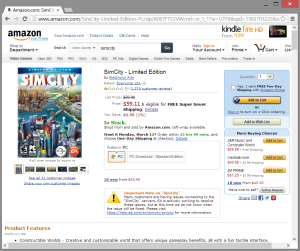 Enter Amazon into the heart of the melee. Eager to spare their customers from what can only be referred to as a kerfuffle, Amazon has stopped selling SimCity on their storefront. In addition to marking each purchase option as “unavailable” when selected, they give Amazon customers a warning: “Many customers are having issues connecting to the “SimCity” servers. EA is actively working to resolve these issues, but at this time we do not know when the issue will be fixed. Please visit https://help.ea.com/en/simcity/simcity for more information.” Click that screenshot I took to see it full-size or hit up Amazon to see it for yourself.
Enter Amazon into the heart of the melee. Eager to spare their customers from what can only be referred to as a kerfuffle, Amazon has stopped selling SimCity on their storefront. In addition to marking each purchase option as “unavailable” when selected, they give Amazon customers a warning: “Many customers are having issues connecting to the “SimCity” servers. EA is actively working to resolve these issues, but at this time we do not know when the issue will be fixed. Please visit https://help.ea.com/en/simcity/simcity for more information.” Click that screenshot I took to see it full-size or hit up Amazon to see it for yourself.
So EA is trying to address the problem. Naturally, they hate bad press and the prospect of losing future sales as much as the next company. Today they announced that they are removing “non-critical” aspects of the game to help lower the stress on their servers, letting more people connect without getting the boot.
Now this is the second launch that I’ve seen destroyed by a publisher’s absolute insistence on always-on DRM (of course i say “destroyed” due to user backlash, not money). It is also the second launch where the publisher claimed that the always on component provided benefits and was not implemented for DRM reasons. “Oh it’s technical” they say – well I ain’t buying it. Diablo III‘s DRM-laden launch was paired with sales. SimCity will still sell a bunch of copies once they get all this sorted out. That’s two kids. One more always-on DRM launch and I’m ready to call it a horrifying industry trend
On an actual technical note, this was the second launch where AAA publishing houses didn’t properly test a stressed server load. You’re requiring every single player to be online. Don’t you think your servers and network should be beefed up to match it?
Tushar Nene
Staff Writer
@tusharnene

When Leia asked me to do a “Clothes inspired by…” article I had to pause and think. What the hell do I know about fashion? I know you don’t wear white after Labor Day, but I’m not sure why. I know high-tops are (and always will be) cooler than any other shoes. And to base the outfits off of superheroes? I don’t know too much about comics. I know Batman’s secret identity is Peter Parker and that’s about it (joking, seriously). It was a formula for disaster.
Then it hit me like an old Hanson song. I had to base my outfits off of MmmBop… wait… no. What was I talking about again?
Oh yeah! So cutting to the chase, I have been granted the grace to make “Outfits Inspired by Video Game Characters“, because I know video games like the back of my hands. This is my first attempt so go easy on me, but if it goes well I have a few other characters I think will turn out well.
Hit the jump to see some outfits for men inspired by Donkey Kong and Vault Boy


